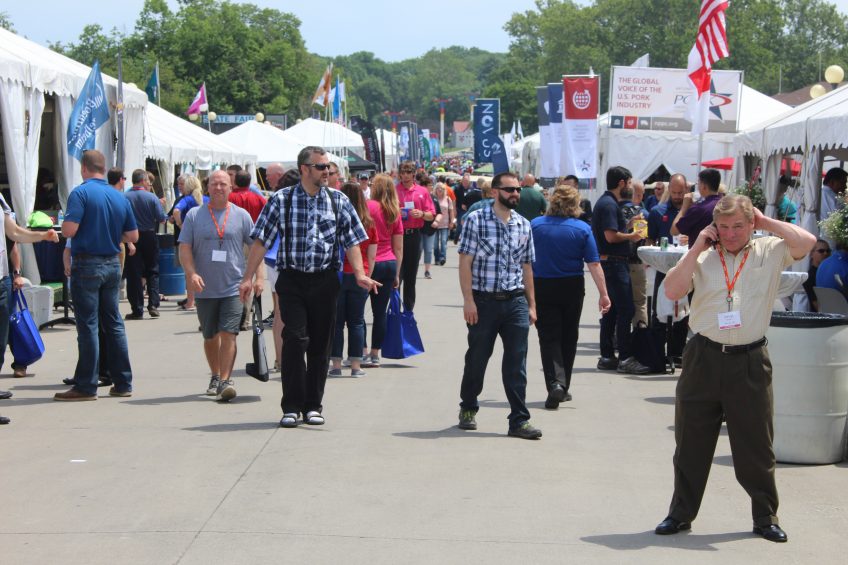Innovations and novelties at World Pork Expo

Fusion feeding for sows, tools how to select gilts and smart air filtration; these were amongst the novelties and innovations showcased at the 2018 edition of the World Pork Expo in Des Moines, IA, United States.
The atmosphere at the show was good, despite the announcement of the Mexican government to introduce retaliatory tariffs to US pork, potentially costing the US pork business millions of dollars.
2nd air conditioned exhibition hall at WPX
For the first time, the World Pork Expo added a 2nd air conditioned exhibition hall to the show. In the past mostly non-air conditioned buildings were used as the 2nd exhibition hall – perhaps not the most optimal given that temperatures during WPX can usually rise to 30ºC (86ºF).
Therefore the addition of the Jacobson Building (built in 2010) to the show hugely benefited opportunities for both exhibitors and visitors. Various prominent companies were able to get larger indoor booths than in the past. Add to this the hustle and bustle of barbecues in the hospitality tents outside, and the 2018 edition reported a substantial increase of the total exhibition area to be now over 33,000 m2 (360,000 square feet).
Mixing ESF and free access stalls
One of the more interesting developments on the US market has been the local solution how to deal with group housing for gestating sows. Last year, Canada-based Jyga Technologies introduced a hybrid version between an Electronic Sow Feeding (ESF) system and a free access stall – and this year more companies followed introducing their version of this concept.

In essence, it is a system in which various free access stalls are placed next to each other, but each is equipped with a feeder, which works like an ESF station and comes with a transponder, after which a personal dose for the sow can be dispensed. The advantage of the system is that it doesn’t require a redesign of a sow barn or management, but can be relatively easily retrofitted into existing farms. Big Dutchman was one of the companies introducing a similar concept, called the BD FusionPro.
Mating station for sows
This year, JyGa Technologies introduced a mating station to its Gestal portfolio, as shown on the picture below, with normally a boar standing behind the hole in the wall. Using RFID, the frequency of a sow’s visit can be recorded and in case she proves to be a regular visitor, automatically, the device will automatically mark her on her back, signalling that she is ready for insemination.

Smart air filtration for swine barns
Another smart technology could be found at the booth of AAF | Flanders, an American ventilation company which found its way to the World Pork Expo for the 1st time. The company introduced a smart filtration system (Sensor360): with sensors the quality of incoming air can be tested by e.g. determining the amount of particles entering. This happens both before and after filtration, so in case there is no difference in air quality, a swine producer can get an alarm on his mobile phone as most probably his filtration system then needs attending to.

Technology to weigh pigs using cameras
Just like at the British Pig & Poultry Fair, both Fancom and Skov presented their technology to weigh animals using cameras. The technology to accurately estimate weight by measuring sizes has been around for some years, but has been getting more perfectionised over the last few years. The Skov version allows an integration of the results into its Web platform FarmOnline.
Manure pit ventilation
Fancom, originally based in the Netherlands, but has become very well embedded in the US market due to its connection to Chore-Time. Hence it was able to introduce a number of solutions that are typically in demand at swine facilities in the States, like e.g. the new Pit I-Fan, a fan small enough to be equipped in the manure pit. Positioned underneath the slats but just above the manure levels, it helps to guide odours out of the facilities.

DuPont introducing nutribiosis
DuPont Industrial Biosciences announced in a press conference that it is to start communicating more around the topic of ‘nutribiosis’, mapping the interaction between gut and immune function, nutrition and microbiome. This is intended to widen the debate about the efficacy of feed additives and ingredients, as these are often measured by average daily gain or feed conversion ratio.
These outcomes, however, often do not state anything on the effects of an additive or ingredient on other aspects of the animal, let alone that it explains its mode of action in detail. DuPont has the scientific and R&D background capacity to offer this kind of insights, said Aart Mateboer, the company’s business unit director for animal nutrition.
Gilt selection – a handout
Last but not least – in a press conference, DSM introduced the next generation of the Gilt Selection poster, a handy overview of what aspects to pay attention to when selecting new gilts on a farm. The poster was made in cooperation with Iowa State University’s professor Ken Stalder, who explained the concept. The poster comes in 2 languages, English on the front and Spanish on the back.












